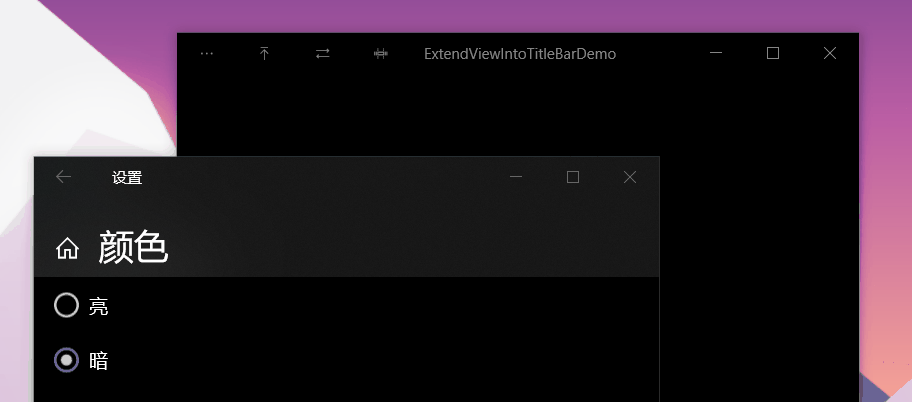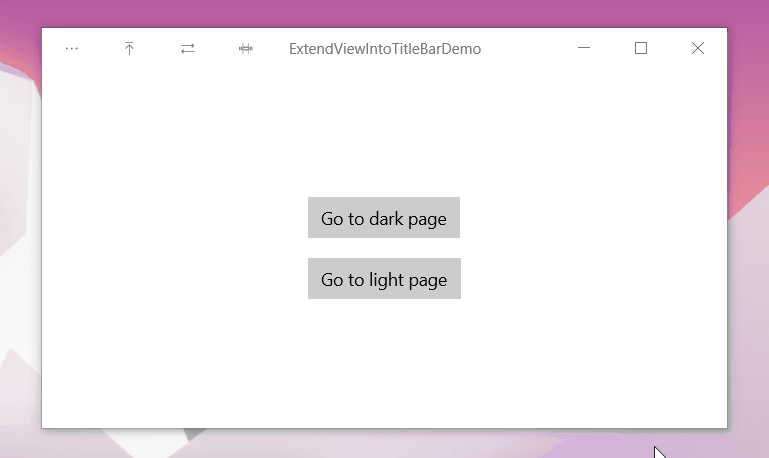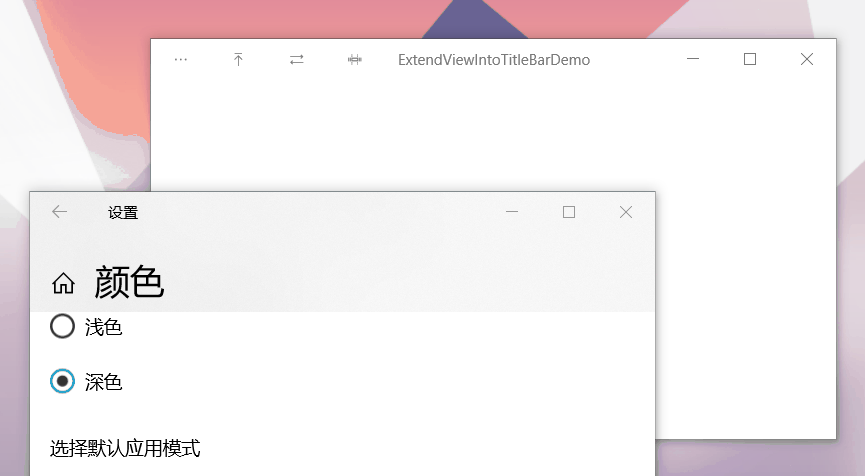[UWP]占领标题栏
- 2019 年 10 月 3 日
- 筆記
1. 前言
每一个有理想的UWP应用都会打标题栏的主意,尤其当微软提供 将 Acrylic 扩展到标题栏 这个功能后,大部分Windows 10的原生应用都不乖了,纷纷占领了标题栏的一亩三分地。这篇博客将介绍在UWP中如何自定义标题栏。
2.示例代码
UWP的限制很多,标题栏的自定义几乎全部内容集中在 这篇文档 里面。但只参考这篇文章做起来还不够顺手,我参考了微软开源的计算器应用中的 TitleBar 写了一个示例应用,可以在 这里 查看它的源码。我也把TitleBar实际应用到了我的 OnePomodoro 应用里面了。
3. 简单的颜色自定义
如果只想简单地自定义标题栏的颜色可以通过ApplicationViewTitleBar,ApplicationViewTitleBar表示应用程序的标题栏,它提供了一些颜色属性用于控制标题栏的颜色,示例代码如下:
// using Windows.UI.ViewManagement; var titleBar = ApplicationView.GetForCurrentView().TitleBar; // Set active window colors titleBar.ForegroundColor = Windows.UI.Colors.White; titleBar.BackgroundColor = Windows.UI.Colors.Green; titleBar.ButtonForegroundColor = Windows.UI.Colors.White; titleBar.ButtonBackgroundColor = Windows.UI.Colors.SeaGreen; titleBar.ButtonHoverForegroundColor = Windows.UI.Colors.White; titleBar.ButtonHoverBackgroundColor = Windows.UI.Colors.DarkSeaGreen; titleBar.ButtonPressedForegroundColor = Windows.UI.Colors.Gray; titleBar.ButtonPressedBackgroundColor = Windows.UI.Colors.LightGreen; // Set inactive window colors titleBar.InactiveForegroundColor = Windows.UI.Colors.Gray; titleBar.InactiveBackgroundColor = Windows.UI.Colors.SeaGreen; titleBar.ButtonInactiveForegroundColor = Windows.UI.Colors.Gray; titleBar.ButtonInactiveBackgroundColor = Windows.UI.Colors.SeaGreen;有几点需要注意:
- 悬停和按下状态的Background定义对关闭按钮无效
- Foreground不能设置透明
4. 将内容扩展到标题栏
若要隐藏默认标题栏并将你的内容扩展到标题栏区域中,请将 CoreApplicationViewTitleBar.ExtendViewIntoTitleBar 属性设置为 true。CoreApplicationViewTitleBar允许应用定义在应用窗口中显示的自定义标题栏。示例代码如下:
// using Windows.ApplicationModel.Core; // Hide default title bar. var coreTitleBar = CoreApplication.GetCurrentView().TitleBar; coreTitleBar.ExtendViewIntoTitleBar = true;5. 将内容扩展到标题栏时自定义标题按钮颜色
将内容扩展到标题栏,标题按钮的颜色就变复杂了。因为应用内容的颜色可能和按钮的颜色冲突。这种情况下有几种方案,其中最简单的一种方案是写死为一个不会冲突的颜色,但切换主题时可能会让这些颜色出问题。计算器应用中订阅UISettings的ColorValuesChanged事件,动态地根据ThemeResources的值改变标题栏颜色,并且更进一步地考虑到使用高对比度主题的情况,所以订阅了AccessibilitySettings的HighContrastChanged事件:
if (_accessibilitySettings.HighContrast) { // Reset to use default colors. applicationTitleBar.ButtonBackgroundColor = null; applicationTitleBar.ButtonForegroundColor = null; applicationTitleBar.ButtonInactiveBackgroundColor = null; applicationTitleBar.ButtonInactiveForegroundColor = null; applicationTitleBar.ButtonHoverBackgroundColor = null; applicationTitleBar.ButtonHoverForegroundColor = null; applicationTitleBar.ButtonPressedBackgroundColor = null; applicationTitleBar.ButtonPressedForegroundColor = null; } else { Color bgColor = Colors.Transparent; Color fgColor = ((SolidColorBrush)Application.Current.Resources["SystemControlPageTextBaseHighBrush"]).Color; Color inactivefgColor = ((SolidColorBrush)Application.Current.Resources["SystemControlForegroundChromeDisabledLowBrush"]).Color; Color hoverbgColor = ((SolidColorBrush)Application.Current.Resources["SystemControlBackgroundListLowBrush"]).Color; Color hoverfgColor = ((SolidColorBrush)Application.Current.Resources["SystemControlForegroundBaseHighBrush"]).Color; Color pressedbgColor = ((SolidColorBrush)Application.Current.Resources["SystemControlBackgroundListMediumBrush"]).Color; Color pressedfgColor = ((SolidColorBrush)Application.Current.Resources["SystemControlForegroundBaseHighBrush"]).Color; applicationTitleBar.ButtonBackgroundColor = bgColor; applicationTitleBar.ButtonForegroundColor = fgColor; applicationTitleBar.ButtonInactiveBackgroundColor = bgColor; applicationTitleBar.ButtonInactiveForegroundColor = inactivefgColor; applicationTitleBar.ButtonHoverBackgroundColor = hoverbgColor; applicationTitleBar.ButtonHoverForegroundColor = hoverfgColor; applicationTitleBar.ButtonPressedBackgroundColor = pressedbgColor; applicationTitleBar.ButtonPressedForegroundColor = pressedfgColor; }这段代码中,当使用高对比度主题时将标题栏的按钮颜色还原成默认值,否则设置成ThemeResource中对应的颜色,运行效果如下:

但现在的UWP应用常常在Dark和Light主题之间反复横跳,而Application.Current.Resources只能拿到程序加载时的ThemeResource的值,所以这段代码在应用内的主题切换后无效。我暂时不清楚怎么在代码里拿到最新的ThemeResource,为解决这个问题只好让TitleBar自己在XAML中获取当前的ThemeResource,代码如下:
<UserControl.Resources> <SolidColorBrush x:Key="ButtonForegroundColor" Color="{ThemeResource SystemBaseHighColor}" /> <SolidColorBrush x:Key="ButtonInactiveForegroundBrush" Color="{ThemeResource SystemChromeDisabledLowColor}" /> <SolidColorBrush x:Key="ButtonHoverBackgroundBrush" Color="{ThemeResource SystemListLowColor}" /> <SolidColorBrush x:Key="ButtonHoverForegroundBrush" Color="{ThemeResource SystemBaseHighColor}" /> <SolidColorBrush x:Key="ButtonPressedBackgroundBrush" Color="{ThemeResource SystemListMediumColor}" /> <SolidColorBrush x:Key="ButtonPressedForegroundBrush" Color="{ThemeResource SystemBaseHighColor}" /> </UserControl.Resources>Color fgColor = ((SolidColorBrush)Resources["ButtonForegroundColor"]).Color; Color inactivefgColor = ((SolidColorBrush)Resources["ButtonInactiveForegroundBrush"]).Color; Color hoverbgColor = ((SolidColorBrush)Resources["ButtonHoverBackgroundBrush"]).Color; Color hoverfgColor = ((SolidColorBrush)Resources["ButtonHoverForegroundBrush"]).Color; Color pressedbgColor = ((SolidColorBrush)Resources["ButtonPressedBackgroundBrush"]).Color; Color pressedfgColor = ((SolidColorBrush)Resources["ButtonPressedForegroundBrush"]).Color;
6. 可拖动区域
都将内容扩展到标题栏了,肯定是想在标题栏上放置自己需要的UI元素,默认情况下标题栏的范围为拖动、点击等Windows的窗体行为保留,在这个范围的自定义UI内容没办法获取鼠标点击。 为了让自定义的UI内容获取鼠标,可以用Window.SetTitleBar方法指定某一元素能用于窗体的拖动和点击。
<Grid x:Name="LayoutRoot" Height="32" HorizontalAlignment="Stretch"> <Grid x:Name="BackgroundElement" Height="32" Background="Transparent" /> <StackPanel Orientation="Horizontal"> <StackPanel x:Name="ItemsPanel" Orientation="Horizontal"> </StackPanel> <TextBlock x:Name="AppName" x:Uid="AppName" Text="ExtendViewIntoTitleBarDemo" </StackPanel> </Grid>Window.Current.SetTitleBar(BackgroundElement);上面的代码指定TitlaBar中的BackgroundElement元素为可拖动区域,而下面的StackPanel则用于放置交互内容,例如标题或后退按钮。这个StackPanel必须比BackgroundElement具有较高的Z顺序才能接收到用户的鼠标输入。
7. 标题的系统保留区域
标题栏的右边有188像素的系统保留区域,用于系统标题按钮(“后退”、“最小化”、“最大化”、“关闭”)。其实这几个按钮也就占用了141像素的控件,还有一小块空间是默认的可拖动区域,这小块空间确保了无论怎么设置都总有一个用户可拖动的区域。

上面说的188像素是100%缩放的情况,通过上面的截图可以看到实际上可能不一样,通常来说会在窗体加载时,或者订阅CoreApplicationViewTitleBar.LayoutMetricsChanged事件,然后通过CoreApplicationViewTitleBar获取具体的值。
_coreTitleBar.LayoutMetricsChanged += OnLayoutMetricsChanged; private void OnLayoutMetricsChanged(CoreApplicationViewTitleBar sender, object args) { LayoutRoot.Height = _coreTitleBar.Height; SetTitleBarPadding(); } private void SetTitleBarPadding() { double leftAddition = 0; double rightAddition = 0; if (FlowDirection == FlowDirection.LeftToRight) { leftAddition = _coreTitleBar.SystemOverlayLeftInset; rightAddition = _coreTitleBar.SystemOverlayRightInset; } else { leftAddition = _coreTitleBar.SystemOverlayRightInset; rightAddition = _coreTitleBar.SystemOverlayLeftInset; } LayoutRoot.Padding = new Thickness(leftAddition, 0, rightAddition, 0); }8. 可交互区域的内容
上面的StackPanel是可交互区域,详细的内容如下:
<StackPanel Orientation="Horizontal"> <StackPanel x:Name="ItemsPanel" Orientation="Horizontal"> <StackPanel.Resources> <Style TargetType="Button" BasedOn="{StaticResource NavigationBackButtonNormalStyle}"> <Setter Property="Foreground" Value="{StaticResource TitleBarForeground}" /> <Setter Property="FontSize" Value="10" /> <Setter Property="Width" Value="46" /> <Setter Property="Height" Value="32" /> <Setter Property="IsTabStop" Value="False" /> </Style> </StackPanel.Resources> </StackPanel> <TextBlock x:Name="AppName" x:Uid="AppName" Text="ExtendViewIntoTitleBarDemo" Margin="12,0,12,0" HorizontalAlignment="Left" VerticalAlignment="Center" Foreground="{ThemeResource SystemControlPageTextBaseHighBrush}" FontSize="12" IsHitTestVisible="False" TextAlignment="Left" TextTrimming="CharacterEllipsis" /> </StackPanel>其中AppName用于显示标题栏,ItemsPanel用于放其它按钮。TitleBar里定义了Buttons属性,调用TitleBar可以通过Buttons属性指定按钮(这部分代码我凌晨两点写的,写得十分敷衍,但写完又懒得改了)。
public ObservableCollection<Button> Buttons { get; } = new ObservableCollection<Button>(); private void OnButtonsCollectionChanged(object sender, System.Collections.Specialized.NotifyCollectionChangedEventArgs e) { ItemsPanel.Children.Clear(); foreach (var button in Buttons) { ItemsPanel.Children.Add(button); } }<local:TitleBar> <local:TitleBar.Buttons> <Button x:Name="OptionsButton" Content="" ToolTipService.ToolTip="Options" /> <Button Content="" ToolTipService.ToolTip="Options" /> <Button Content="" ToolTipService.ToolTip="Options" /> <Button Content="" ToolTipService.ToolTip="Options" /> </local:TitleBar.Buttons> </local:TitleBar>
按钮的样式来自NavigationBackButtonNormalStyle并稍作修改,大致上做到和标准的标题栏按钮一样。
9. 非激活状态的标题栏颜色
当窗体处于非激活状态应该让按钮和标题都变灰,可以订阅Window的Activated事件,在非激活状态时改变颜色:
Window.Current.Activated += OnWindowActivated; private void OnWindowActivated(Object sender, WindowActivatedEventArgs e) { VisualStateManager.GoToState( this, e.WindowActivationState == CoreWindowActivationState.Deactivated ? WindowNotFocused.Name : WindowFocused.Name, false); }<UserControl.Resources> <SolidColorBrush x:Key="TitleBarForeground" x:Name="TitleBarForeground" Color="{ThemeResource SystemBaseHighColor}" /> </UserControl.Resources> <Grid x:Name="LayoutRoot" Height="32" HorizontalAlignment="Stretch"> <VisualStateManager.VisualStateGroups> <VisualStateGroup x:Name="WindowFocusStates"> <VisualState x:Name="WindowFocused" /> <VisualState x:Name="WindowNotFocused"> <VisualState.Setters> <Setter Target="AppName.Foreground" Value="{ThemeResource SystemControlForegroundChromeDisabledLowBrush}" /> <Setter Target="TitleBarForeground.Color" Value="{ThemeResource SystemChromeDisabledLowColor}" /> </VisualState.Setters> </VisualState> </VisualStateGroup> </VisualStateManager.VisualStateGroups>
10. 全屏和平板模式
当应用在全屏或平板模式下运行时,系统将隐藏标题栏和标题控制按钮。 但是,用户可以调用标题栏,以使其以覆盖形式显示在应用的 UI 顶部。 你可以处理隐藏或调用标题栏时将通知的 CoreApplicationViewTitleBar.IsVisibleChanged 事件,并根据需要显示或隐藏你的自定义标题栏内容。
LayoutRoot.Visibility = _coreTitleBar.IsVisible ? Visibility.Visible : Visibility.Collapsed;这部分比较难截图就不搞了,想看效果可以试玩我的番茄钟应用。
11.结语
就这样,令人头痛的自定义标题栏处理完了。还好微软开源了它的计算器里正好有我需要的代码,抄了个爽。有一些处理得不好,如果错误请指正。
12.参考
calculator_TitleBar.xaml.cpp at master
ApplicationViewTitleBar Class (Windows.UI.ViewManagement) – Windows UWP applications Microsoft Docs
13. 源码
DinoChan_ExtendViewIntoTitleBarDemo How to handle titlebar when ExtendViewIntoTitleBar
OnePomodoro_TitleBar.xaml at master
